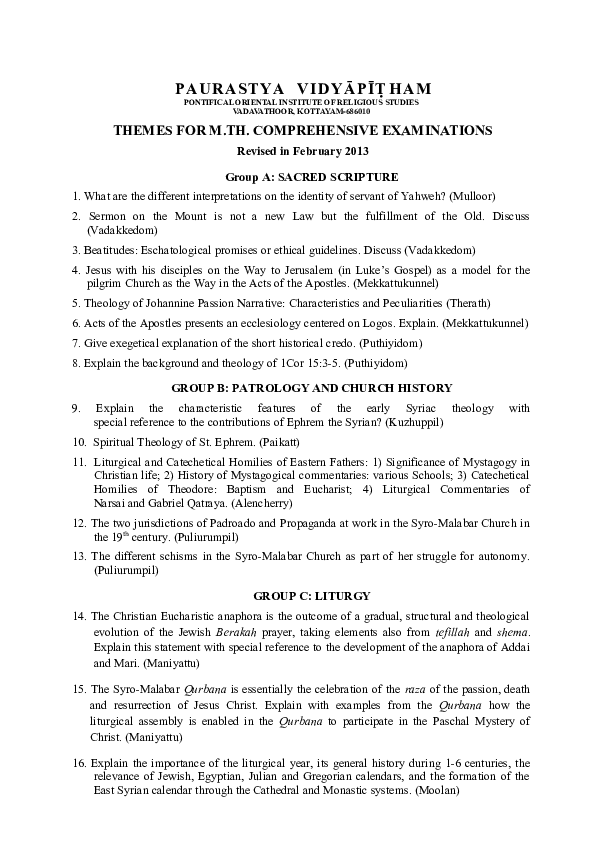Academia.edu no longer supports Internet Explorer.
To browse Academia.edu and the wider internet faster and more securely, please take a few seconds to upgrade your browser.
Related Papers
HIRS, Changanacherry
The Liturgical Heritage of the Syro-Malabar Church: Shadows and Realities.PDF2019 •
This book pivots on three main themes: inculturation, liturgical reform and the direction of the celebrant during the Holy Mass, although it touches also some other aspects of the liturgical heritage of the Syro-Malabar Church. Really these two questions have been the root causes of disputes, indiscipline and anarchy among some sections of the clergy and the Christian faithful, which have tormented this Church for more than five decades. The present work not only traces the origin and historical evolution of the said problems, but also highlights the advancement of the restoration and reform of liturgy, distinguishing shadows from realities and striving to enucleate some guidelines and orientational paradigms for future action. [The statements concerning the liturgy facing the people in the Latin Church may simply be considered as the observations of an Eastern outsider].
HIRS, Changanacherry
Roman Pontifical into Syriac and the Beginning of Liturgical Reform in the Syro-Malabar Church: History of the Revision and Publication of the Chaldean and Syro-Malabar Pontifical2012 •
In this book the authors present 44 important documents, which provide us with precise information concerning the start of liturgical restoration and reform in the Syro-Malabar Church, efforts of the bishops of this Church to have a translation of the Roman Pontifical into Syriac and to obtain the approval of the Holy See, studies and votes of the experts and consultants of the Oriental Congregation, reports, discussions and resolutions of the plenary meetings of the Cardinals as well as important decisions and directives of the Roman Pontiffs.
Disputatio philosofica: International Journal on Philosophy and Religion
EXAMINATION OF CHRISTIAN LITURGY IN THE JOURNAL ISLAMSKA MISAO2023 •
What characterizes Islam is its openness to other religions and the "spirit of dialogue", which is one of the essential ideas of the Holy Qur'an. For the dialogue to take place, the Other is required, the one who will try to understand. The journal Islamska misao (Islamic Thought) was partly dedicated to the said idea, which is substantiated by the texts that we aim to analyze in this paper. All of this testifies to a slow opening that characterized the period in which the journal was published, and both political emancipation, as well as the need to understand others to whom Muslims are directly addressed in their totality. Special emphasis is placed on the Christian ritualistic aspect, where we show numerous conceptual similarities in many religions, as well as peculiarities, all of which contribute to a more diverse religious spectrum which is in Islam perceived as a reflection of the divine plan or will. This is what Muslim authors had in mind when choosing topics in the journal.
RELATED PAPERS
Beyond the Polis. Rituals, Rites and Cults in Early and Archaic Greece, I. S. Lemos, A. Tsingarida eds
Rituals in context. Scales and Horizons of Interpretation of Cult Places in Early Greece2019 •
2023 •
TÜRKİYE BİLİMLER AKADEMİSİ ARKEOLOJİ DERGİSİ
The Geometric and Archaic Period Tombs Uncovered in the South Necropolis at Euromos2018 •
The Rule of Law Under Threat. Eroding Institutions and European Remedies
Political Strategies to Overcome the Rule of Law Crisis Taking into Account National Political Discourses -The Case of East Central European EU Member States 12024 •
2023 •
Clinical Rheumatology
Cytokines (IL-15, IL-21, and IFN-γ) in rheumatoid arthritis: association with positivity to autoantibodies (RF, anti-CCP, anti-MCV, and anti-PADI4) and clinical activity2019 •
Value in Health Regional Issues
Comparación de costos y resultados sanitarios de usuarios con neumonia adquirida en comunidad atendidos en domicilio o en hospitalización tradicional: estudio exploratorio de 40 casos2015 •
2013 •
Enfermería Global
Propuesta de políticas administrativas de recursos humanos para el departamento de enfermería de un hospital tipo III de San Felipe2010 •
HAL (Le Centre pour la Communication Scientifique Directe)
Technology: An Exit Strategy for COVID-19?2020 •
Kansas Agricultural Experiment Station Research Reports
Effect of Sample Preparation and Extended Mix Times with Different Salt Particle Sizes on the Uniformity of Mix of a Corn-Soybean Meal Swine Diet2016 •
RELATED TOPICS
- Find new research papers in:
- Physics
- Chemistry
- Biology
- Health Sciences
- Ecology
- Earth Sciences
- Cognitive Science
- Mathematics
- Computer Science


 SHEEN PROVIDENCE OSB
SHEEN PROVIDENCE OSB